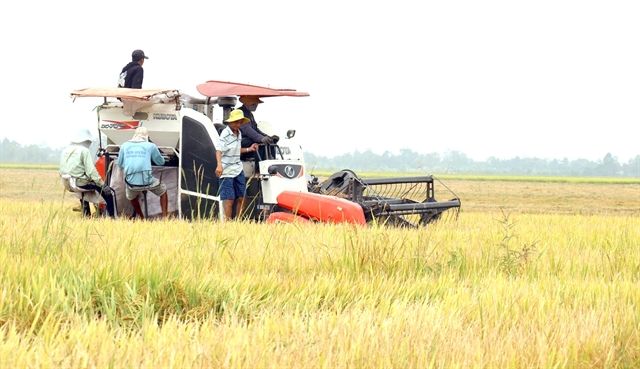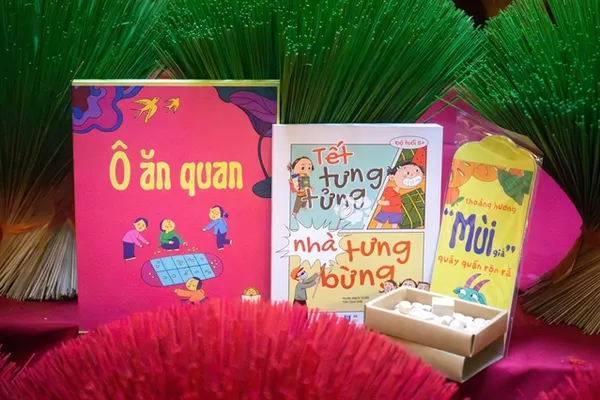 Society
Society

The Cửu Long (Mekong) Delta province of Kiên Giang has managed outstanding socio – economic development this year despite the COVID – 19 pandemic, according to its People’s Committee.

|
| Harvesting the 2020 – 21 winter – spring rice in Kiên Giang Province’s Tân Hiệp District. Farmers in the province are enjoying a bumper harvest and high rice prices. – VNA/VNS Photo Lê Huy Hải |
KIÊN GIANG — The Cửu Long (Mekong) Delta province of Kiên Giang has managed outstanding socio-economic development in the first five months of this year despite the COVID-19 pandemic, according to its People’s Committee.
Lâm Minh Thành, its chairman, attributed it to authorities at all levels proactively implementing development measures.
Most sectors have achieved excellent growth so far, he said.
Industrial production grew by 10.6 per cent year-on-year to more than VNĐ20.4 trillion (US$870 million).
Its retail sales and services grew by 10 per cent to VNĐ 49.8 trillion ($2.16 billion).
Exports were up nearly 16 per cent at $317 million, with rice accounting for $111 million and seafood for $94 million.
Farmers in the province reaped a bumper harvest and got high prices for the 2020-21 winter – spring rice crop to earn an average of VNĐ40 million ($1,740) per hectare, according to the province Department of Agriculture and Rural Development.
Aquaculture output was up 9.1 per cent at more than 62,000 tonnes.
The province targets total exports of $750 million this year, and to step up promotion of agricultural products to expand export markets and boost the output of key items rice and seafood.
Agriculture production
Kiên Giang has been the country’s largest rice producer for long, and more than 50 per cent of its workforce is in the agricultural sector.
The province has implemented various measures to develop agriculture, especially rice and seafood production, in recent years.
They include developing efficient faming models adapted to climate change and sustainable development.
The province is developing the large-scale rice field model in which farmers pool their fields, grow the same rice varieties, use the same farming techniques and have the same crop schedule under contracts that guarantee purchase of the entire harvest.
It is also developing aquaculture, especially the models of breeding shrimp under advanced farming techniques and other environmental friendly models like rice – shrimp farming model in coastal areas.
Under the rice-shrimp farming model, farmers rotate between rice in the rainy season and shrimp in the dry season on the same field to adapt to saltwater intrusion in coastal areas.
The model also produces clean rice and shrimp as farmers use few chemicals.
They harvest about 4 – 4.5 tonnes of rice and 450 – 500 kg of shrimp per hectare annually, earning VNĐ100 – 130 million ($4,300 – 5,600), according to the Department of Agriculture and Rural Development.
With a coastline of more than 200 kilometres, the province plans to turn more mono-rice fields in coastal areas into rice-shrimp farming fields to adapt to climate change.
Hòn Đất District, which has the largest area under rice in the province, is zoned for 16,000ha of rice-shrimp fields in coastal areas by 2030, according to its Bureau of Agriculture and Rural Development.
“Farmers in the district are actively turning monoculture rice fields into rice-shrimp fields,” Lê Văn Giàu, head of the bureau, said.
“The district plans to have 2,500ha of rice-shrimp fields this year.”
In 2017-20 the province switched to other crops and aquaculture on more than 32,800ha of unproductive rice fields, helping increase production efficiency and farmers’ incomes.
The income from these fields has been increased by 35 per cent, according to the Department of Agriculture and Rural Development.
Quảng Trọng Thao, deputy director of the department, said the province has restructured its crops to suit conditions in each area and achieved high efficiency.
Besides, it has boosted the use of advanced farming techniques and machinery to improve yield and quality and reduce costs, he said.
Kiên Giang had more 725,800ha under paddy and harvested 4.5 million tonnes last year, 5 per cent more than the target.
It also had 100 large-scale rice fields with a combined area of 30,672ha last year.
To sustainably develop agriculture, it has strengthened investment in infrastructure, especially irrigation, to prevent saltwater intrusion and secure water for cultivation, according to the Department of Agriculture and Rural Development.
It has built hundreds of temporary dams to prevent saltwater intrusion and store freshwater, properly regulated the operation of sluices and electric pumping stations to supply water to the Long Xuyên Quadrangle, the western part of the Hậu River delta and the U Minh Thượng region.
In the ongoing summer – autumn rice crop, the province plans to grow 280,000ha of rice and harvest an estimated 5 – 60 tonnes per hectare.
The province’s rice output will be 4.2 million tonnes this year, according to the Department of Agriculture and Rural Development.
The province plans to breed brackish water shrimp on 136,000ha this year using industrial, semi-industrial, advanced extensive and rice – shrimp farming models.
It has developed concentrated farming areas and value chains for key products like rice, vegetables, mango, pineapple, and pepper on a total area of more than 100,000ha.
Its average annual agricultural output per hectare last year was worth VNĐ100 million ($4,300), up nearly VNĐ22 million since 2015, according to the department. VNS




